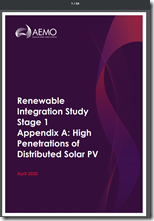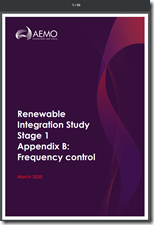I’m not going to make a habit of posting an article each time some central body posts some Report/Study, as I’d get nothing else done – however in this case (just like with the COAG Energy Council’s two discussion papers on ‘NEM 2.0’) I sense I’ll be referring back to this one a number of times in future, so it’s worth noting this one here this morning.
Note that I’m also doing this as experience has taught me that documents on the AEMO website (including through several website redesigns) tend to move around quite a bit over the years, so I’m posting this article here in order to provide a more durable link to the content.
Thursday 30th April 2020 sees the AEMO release it’s first* ‘Renewable Integration Study’, and my sense is that it’s not a moment too soon given some of the challenges we’ve grown increasingly aware of in the past couple of years – and also some looming challenges we’re collectively not speaking too much about (though might post more about via WattClarity in the coming months).
* note that I say here ‘first’ as it is a first of its kind under this specific title, I believe. However others in our team have recollections of a ‘Wind Integration Study’ published perhaps 5 years ago or so (I can’t find this now on the AEMO website, unfortunately – it might have had a different formal name, or been moved).
PS1 – Earlier ‘Integration Studies’ published by the AEMO
A group of readers have pointed me at a number of precursor studies – thanks for that! There are also comments at the bottom of this article that link to others. Some of the following were badged “SA” because that was the main focus of the investigations at the time (though the concerns they covered were really NEM-wide, just appearing in SA first):
(A) Marcelle (thanks!) has found this link to an earlier external study (Nov 2011) on ‘Lessons Learned from International Wind Integration Studies’, which was commissioned by the AEMO. This was referenced in the 2013 report noted below.
(B) There was obviously the study completed by the AEMO (July 2013) at the request of the Australian Government at the time for ‘100% Renewables Study – Modelling Outcomes’:
(B1) I can’t currently find it in a quick search of the AEMO website now – and where it was on the Dept Environment website is now a broken link (but we do have an electronic copy in our own ‘eLibrary’ so might upload, if it is of enough interest).
(B2) Some of our readers will remember how:
(i) the types of high-level modelling completed for that project was not of the same type (or had the same focus) as those that are now the focus – i.e. back then the focus was more on ‘Reliability’ (i.e. like the ESOO) than on ‘Security’.
(ii) Back then, Geothermal featured in the modelled results in a large way (>10GW of ‘baseload’ renewable supply).
(C) This was followed (sometime in 2013) by the ‘Integrating Renewable Energy – Wind Integration Studies Report’ by AEMO.
(D) That was followed in October 2014 by the ‘Renewable Energy Integration in South Australia’ report by AEMO and ElectraNet (my understanding is that it was an AEMO-led project with ElectraNet added in towards the end).
(E) The October 2014 report was updated on 19th February 2016 with the longer ‘Update to the Renewable Energy Integration in South Australia’ report, again jointly published between AEMO and ElectraNet.
As an interesting aside in this report (published Feb 2016, seven months before the SA System Black includes the (perhaps prophetic?) statement on the page numbered 28 (page 30 in the PDF sequence):
“The results showed that:
> As inertia reduces, the minimum frequency is lower (i.e. greater under frequency excursion) before the current AUFLS scheme design can arrest the frequency drop.
> For high rooftop PV generation, the minimum level of inertia required to maintain frequency following islanding of SA is 4,500 MWs.”
In hindsight we now know what happened on 28th September 2016 – and we also reverse-engineered how the level of inertia in the SA grid had declined over a number of years to that point in the GRC2018, as noted here later. The lowest level in a month had been well below 4,500MWs for a number of years prior to that time!
That real-world (and very tangible) example will help to reinforce why these ‘integration studies’ are quite important, and should be reviewed in detail as much more than an academic exercise.
(F) Someone else has also flagged this (April 2016) ‘Response of Existing PV inverters to frequency disturbances’ report looking at one specific challenge of this energy transition.
(G) This ‘Future Power System Security Program – Reports and Analysis’ page currently on the AEMO website links to other related documentation as well (but alas not the 2012 100% renewable study, for completeness.
(H) Also, we’ve worked out that there’s a ‘Reference Resources’ list at the back (i.e. from page 70) of this ‘Renewable Integration Study Stage 1’ report that will prove quite useful for a number of people. Alas, there is a link provided to the old 100% Renewables study on the old Department of Environment website, but that link does not work any more (the victim of the recent ministerial reshuffle?)
Finally, remember the other links in comments below!
Links on the AEMO website are currently here:
1) To the News Release for the study; and
2) To the Study itself.
I’ve not read them, yet, but I do notice AEMO has assembled them into 5 bite-sized chunks of information, starting with the 75-page main ‘Stage 1’ report:
Given we’d invested countless hours (with Greenview Strategic Consulting, and with the assistance of others) in compiling our the Generator Report Card 2018 11 months ago now, and in that had analysed a number of different aspects of challenge arising both sides of the ‘out with the old, and in with the new’ energy transition, I will be interested to review and see how many of the concerns raised in the GRC2018 have been covered in this Renewable Integration Study.
This 75-page main report also links to four supplementary documents, all roughly the same length in addition:
| Appendix A High Penetrations of Distributed Solar PV |
Appendix B Frequency Control |
Appendix C Managing Variability and Uncertainty |
Appendix D (though not named as such!) International perspectives |
 |
 |
 |
 |
| I’ve already written a number of times about the challenges inherent in the opacity of distributed small-scale solar PV output, and I know that’s far from the most significant challenge faced here.
Hence will be quite interested in what the AEMO has covered in Appendix A. |
The AEMC has recently passed a rule change on Primary Frequency Control – however my understanding is that this is only intended as an interim measure.
Hence will be interested to see what’s in Appendix B. |
On WattClarity we have have written a number of times about challenges like this (such as with respect to this inherent belief that some have that ‘diversity will cure it’).
I’ll read this one with great interest. |
Not sure why this was not just labelled ‘Appendix D’, but will review with keen interest. |
(A) AEMO calling for submissions
There’s a consultation process (noted at the bottom of this page) that talks about submissions in June 2020.
As noted before, we very rarely make formal submissions – however it seems likely that there will be other articles on WattClarity in between now and the end of June that discuss various aspects of the core challenges inherent in integrating renewables into the NEM. When we do this (and if I remember) I’ll try to link them in here for completeness:
| Date | Related WattClarity® Articles Topic and Context |
| Tuesday 2nd June 2020 07:00-09:00 NEM time |
The Energy Systems Integration Group (ESIG) is hosting a webinar on the AEMO’s RIS on the morning of Tuesday 2nd June 2020 that’s free to attend. |
| xx June | Might have time to contribute some thoughts via an article at some point. |
I hope these articles (to come) prove useful.
(B) Media Coverage of the release
It’s understandable that there’s also media coverage, so it’s worth linking to some of these:
1) In the AFR, Angela Macdonald-Smith wrote ‘Renewable power to be wasted without reforms: AEMO’ and includes this quote:
“AEMO said the power system already needs near-daily interventions* to keep the lights on and supply secure in regions with high shares of renewables such as South Australia.
As the share of wind and solar further increases, the complexity of running the market grows because of increasing volatility in generation levels, uncertain demand and a weakening in system strength as traditional fossil generators close down.”
… and that AFR article linked in ‘The diabolical task of clean energy transition’ written on 14th January 2020 by Elouise Fowler with Angela.
* note that the ‘daily interventions’ were discussed in some detail in Theme 9 within Part 2 of the 180-page analytical component within the GRC2018:
2) In the Australian, Perry Williams wrote ‘Changes needed ahead of clean energy switch: AEMO’ .
3) In the SMH, Peter Hannam and Mike Foley wrote ‘Australia’s grid could handle a huge leap in renewable power by 2025’ and included the note:
There have been concerns that Australia’s grid, which was designed to connect to a handful of large scale generators, would not cope with the array of solar panels and wind turbines.
But in the new report, AEMO says it believes careful regulation of power generation can overcome these concerns.
Achieving the three-quarter share will need changes in markets and regulation otherwise AEMO will have to impose curbs on renewable energy to ensure grid stability, Ms Zibelman said.
4) In RenewEconomy, Giles Parkinson wrote ‘AEMO lays out “action plan” to manage 75 pct wind and solar by 2025’ :
I note the 75% number referenced was for instantaneous contributions in some dispatch intervals in the AEMO’s base case (i.e. “central”) scenario – not an aggregate over time.
Giles notes AEMO’s support for ‘ahead markets’ (terminology coined in the COAG Energy Council’s second discussion paper on ‘NEM 2.0’).




these previous AEMO reports come to mind
2013 Wind integration
https://www.aemo.com.au/-/media/files/pdf/integrating-renewable-energy–wind-integration-studies-report-2013pdf.pdf
2015 emerging technologies
https://www.aemo.com.au/-/media/Files/PDF/Emerging-Technologies-Information-Paper.pdf
2017 Advice to commonwealth government on dispatchable capability
https://www.aemo.com.au/-/media/Files/Media_Centre/2017/Advice-To-Commonwealth-Government-On-Dispatchable-Capability.PDF
Plus several ‘system study’ and ‘dispatchability’ type reports.
Well switching off their rooftop solar dumping payments will ruffle a few feathers as they’re already grumbling about falling feed in prices being paid by retailers-
https://www.msn.com/en-au/money/markets/energy-operator-wants-to-remotely-switch-off-rooftop-solar-systems-amid-uncontrolled-growth/ar-BB13pbOi
I also note in April Australia’s wind energy output varied from 62.3% of installed capacity down to 1.3% so I can appreciate the AEMO’s problem dealing with the big picture- https://anero.id/energy/wind-energy/2020/april
Averages can certainly hide a multitude of sins but it would appear that flattening curves is very much in vogue at present.
Hi Paul, I was on the CSIRO team that produced input reports for their 100% renewables study in 2013. I have several of those still, so let me know if you’d like the main report or any of the input studies. Cheers, Geoff.